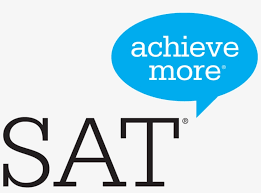
-
SAT Information for Students and Parents
The SAT reasoning test is a measure of the critical thinking skills needed for academic success in college. The SAT assesses how well a student analyzes and solves problems.
The new test is more focused on the skills and knowledge at the heart of education. It measures:
• What you learn in high school
• What you need to succeed in college
If you think the key to a high score is memorizing words and facts you'll never use in the real world, think again!
The same habits and choices that lead to success in school will help you get ready for the SAT. The best way to prepare is to:
• Take the challenging courses
• Do your homework
• Prepare for test and quizzes
• Ask and answer lots of questions
In short, take charge and learn as much as you can!
Know what to expect.
Reading Test
It’s About the Everyday
The Reading Test focuses on the skills and knowledge at the heart of education: the stuff you’ve been learning in high school, the stuff you’ll need to succeed in college. It’s about how you take in, think about, and use information. And guess what? You’ve been doing that for years.
It’s not about how well you memorize facts and definitions, so you won’t need to use flashcards or insider tricks or spend all night cramming.
Quick Facts
- All Reading Test questions are multiple-choice and based on passages.
- Some passages are paired with other passages.
- Informational graphics, such as tables, graphs, and charts, accompany some passages—but no math is required.
- Prior topic-specific knowledge is never tested.
- The Reading Test is part of the Evidence-Based Reading and Writing section.
Writing and Language test
It’s About the Everyday
When you take the Writing and Language Test, you’ll do three things that people do all the time when they write and edit:
- Read.
- Find mistakes and weaknesses.
- Fix them.
The good news: You do these things every time you proofread your own schoolwork or workshop essays with a friend.
It’s the practical skills you use to spot and correct problems—the stuff you’ve been learning in high school and the stuff you’ll need to succeed in college—that the test measures.
Quick Facts
- All questions are multiple-choice and based on passages.
- Some passages are accompanied by informational graphics, such as tables, graphs, and charts—but no math is required.
- Prior topic knowledge is never tested.
- The Writing and Language Test is part of the Evidence-Based Reading and Writing section.
Math Test
It’s About the Real World
Instead of testing you on every math topic, there is, the SAT asks you to use the math that you’ll rely on most in all sorts of situations. Questions on the Math Test are designed to mirror the problem solving and modeling you’ll do in:
- College math, science, and social science courses
- The jobs that you hold
- Your personal life
For instance, to answer some questions you’ll need to use several steps—because in the real world a single calculation is rarely enough to get the job done.
Quick Facts
- Most math questions will be multiple-choice, but some—called grid-ins—ask you to come up with the answer rather than select the answer.
- The Math Test is divided into two portions: Math Test–Calculator and Math Test–No Calculator.
- Some parts of the test include several questions about a single scenario.
Focus
The Math Test will focus in-depth on the three areas of math that play the biggest role in a wide range of college majors and careers:
- Heart of Algebra, which focuses on the mastery of linear equations and systems.
- Problem Solving and Data Analysis, which is about being quantitatively literate.
- Passport to Advanced Math, which features questions that require the manipulation of complex equations.
The Math Test also draws on Additional Topics in Math, including the geometry and trigonometry most relevant to college and career readiness.
SAT Essay
It’s About the Real World
The SAT Essay is a lot like a typical college writing assignment in which you’re asked to analyze a text. Take the SAT with Essay and show colleges that you’re ready to come to campus and write.
What You’ll Do
- Read a passage.
- Explain how the author builds an argument to persuade an audience.
- Support your explanation with evidence from the passage.
What’s New
The SAT’s essay component has had a total makeover:
- It’s optional—but some schools will require it. Get College SAT Essay policies.
- You have 50 minutes to complete your essay, 25 minutes more than the required essay on the old SAT.
- You won’t be asked to agree or disagree with a position on a topic or to write about your personal experience.
Score Structure
Total Score: 400-1600 Evidence-Based Reading and Writing Section: 200-800 Math Section: 200-800 SAT Essay: Three scores ranging from 2-8



